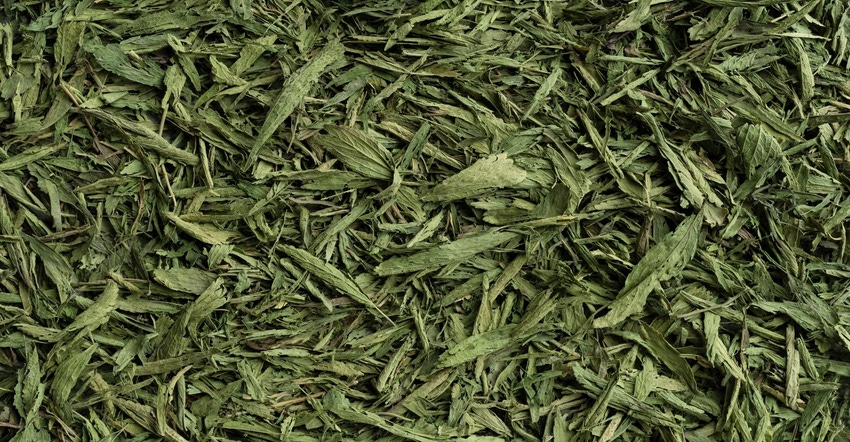Reb A from stevia has made strides as a sugar alternative, but Reb M is another steviol glycoside with great market potential.

The world of sports is one of constant innovation—from scorekeeping to equipment to fan experience. It’s no surprise that sports nutrition has followed suit. Rebaudioside M, or Reb M for short, has proven to be a game-changing ingredient in the production of food and beverages that fall under this and other categories. A zero-calorie, GRAS (generally recognized as safe) sweetener about 300 times sweeter than sugar, Reb M appeals to producers who are paying attention to their customers’ desires for healthier consumable products that still taste good. On top of that, consumers want lower-calorie ingredient alternatives of natural origin.
Reb M comes straight from the earth. It is a steviol glycoside derived from the leaves of the Stevia rebaudiana plant species, whose properties have been studied for over 100 years. The genus Stevia of the Asteraceae family includes 230 species, but Stevia rebaudiana Bertoni is the only one that produces sweet steviol glycosides.1 This perennial shrub, sometimes referred to as “candy leaf” or “honey leaf,” has been around since ancient times and is native to Brazil and Paraguay. As demand for the plant’s sweetening powers has increased, cultivation has expanded from South America to Asia, Europe and North America,2 a major win for domestic production in the wake of the Covid-19 pandemic. Among the 30 steviol glycosides in Stevia rebaudiana, Reb A is present in the highest levels, while Reb M is found only in very low concentrations (about 0.1%) in the plant’s dried leaves. With a sweetness profile comparable to aspartame, which is 200 times as sweet as sucrose, it’s no wonder that steviol glycosides are all the rage in the food and beverage sector. Plus, data suggest stevia has anti-hypertensive, anti-obesity, anti-diabetic, antioxidant, anti-cancer, anti-inflammatory and antimicrobial effects, as well as helping improve kidney function.1
Sweet comparison
As the most popular steviol glycoside, Reb A is the sweetest of all the natural compounds in the stevia leaf.3 It possesses a clean, sweet taste with a slightly bitter, lingering licorice or anise aftertaste. Reb A is a plentiful, viable sugar substitute in formulations where other flavors mask this bitterness. The major upside of Reb M is a complete absence of bitter aftertaste, but it is not without its drawbacks. Reb A’s 2008 self-approved GRAS status predates that of Reb M (2019) by more than a decade, which has allowed supply of Reb A to grow to meet demand. Reb M is newer to the market and hasn’t had the same opportunity. Further, because Reb M naturally occurs in such small concentrations, it inherently carries a higher price tag. Barring future breakthroughs, the maximum global production of Reb M will remain limited, making it an expensive fit for mass-market formulations. All of these factors (cost, taste, availability, target market) need to be considered before choosing the best option for a product.
Benefits, applications
The numerous benefits of Reb M have led to numerous applications. According to Consumer Reports, three-fourths of American adults are trying to reduce their sugar intake. However, this proves challenging when artificial sweeteners don’t deliver sugar’s beloved taste.
Enter Reb M Stevia. When measured with the Beidler model, the sweetener is an estimated 200-350 times more potent than sucrose.3 Uses and use levels for Reb M are expected to be similar to those currently permitted for other high-intensity sweeteners. Likewise, use levels are “self-limiting” based on organoleptic properties (e.g., sweetness potency), as a little goes a long way.
Since Reb M is zero-glycemic, those at risk for or living with diabetes may be able to enjoy foods and beverages that substitute it for sugar or high-fructose corn syrup. In fact, Reb M has shown to be well-suited for blending and is functional in a wide variety of food and beverage products, including bakery, confectionery, dairy, soft drinks, juice, protein shakes and even cocktails.3 Carrying 6 glucose units, Reb M has a low sweetness threshold and high maximum sweet intensity.4 A product with this level of versatility, potency and taste profile makes Reb M a serious contender in America’s battle to reduce sugar intake.
Sports nutrition
Reb M makes sense in many sectors of the food and beverage industry, but it has the potential to be an all-star in the sports nutrition industry. “Positive demand shock” occurred across all regions amid the pandemic. In 2020 alone, the global sports drink market grew 7.7%, and is further projected to grow from $27.22 billion in 2021 to $36.35 billion in 2028, at a compound annual growth rate (CAGR) of 4.2%, per Fortune Business Insights.
Another consideration is that “sports drinks” or hydration drinks, are no longer just for athletes, but for anyone who falls on the broad spectrum of living an active lifestyle. Any beverage intended to hydrate and including electrolytes (sodium, potassium, calcium, magnesium, etc.) can fall under this category. More so, beverages ranging Gatorade to Liquid I.V. have gained a reputation for delivering good taste as well as refreshment. The sports nutrition industry has a wider reach than meets the eye.
Global marketplace
The global stevia market is also on an upward trajectory. Mordor Intelligence projected a CAGR of 8.43% from 2021-2026. Record demand for healthy products—an outgrowth of the pandemic—plus rising concerns about diabetes and obesity mean that the market is primed and ready for what’s next. The unprecedented growth potential of both the sports nutrition and stevia industries presents a new market opportunity for producers willing to dive in with Reb M.
However, Reb M is not without competition, sharing the market with other high-intensity sweeteners such as aspartame, acesulfame potassium (K) and sucralose. These three competitors, though, have been tied to potential concerns meriting further research:
• Anecdotal reports suggest some people have suffered neurological or behavioral reactions in association with aspartame consumption.5
• Studies have shown consuming acesulfame K can perturb the gut microbiome and therefore cause weight gain.6
• Both human and rodent studies demonstrated sucralose may alter glucose, insulin and glucagon-like peptide-1 (GLP-1) levels.6
Production considerations
As with any ingredient, pursuing transparency is a must. For instance, some Reb M is made via fermentation of sugars with genetically engineered yeast, and therefore cannot be described as “stevia leaf extract.” Brand owners should take stock of their desired product attributes (such as using natural methods of production) and then ensure any ingredient and food additive distributor partners are on the same page.
For formulators looking to ditch sugar, Reb M offers advantages such as natural origin, lack of calories, domestic availability and relative novelty. The sweetener provides an opportunity to update old, tired formulas or create brand-new ones. Whether in the next great sports beverage or any other product, the time to formulate with Reb M is now.
Bob Wills has worked in the specialty chemical, food additive and ingredient distribution industry since 2008. As a director of sales for Viachem, his responsibilities include management of the food, beverage and nutritional market segments, coordinating and managing sales efforts, and pursuing growth opportunities on the producer and end-user level. Wills wants potential producer partners as well as end-users to make the most educated decisions possible about what goes into their products.
References
1 Peteliuk V et al. “Natural sweetener Stevia rebaudiana: Functionalities, health benefits and potential risks.” EXCLI J. 2021;20:1412-1430.
2 Wang Y et al. “Comparative transcriptomic of Stevia rebaudiana provides insight into rebaudioside D and rebaudioside M biosynthesis.” Plant Physiol Biochem. 2021;167:541-549.
3 Prakash I et al. “Development of Next Generation Stevia Sweetener: Rebaudioside M.” Foods. 2014;3(1):162-175.
4 Olsson K et al. “Microbial production of next-generation stevia sweeteners. Microb Cell Fact. 2016;15(1):207.
5 Maher TJ and Wurtman RJ. “Possible neurologic effects of aspartame, a widely used food additive.” Environmental Health Perspectives. 1987;75:53-57.
6 Bian X et al. “The artificial sweetener acesulfame potassium affects the gut microbiome and body weight gain in CD-1 mice.” PLoS ONE. 2017;12(6):e0178426.
About the Author(s)
You May Also Like






.png?width=800&auto=webp&quality=80&disable=upscale)